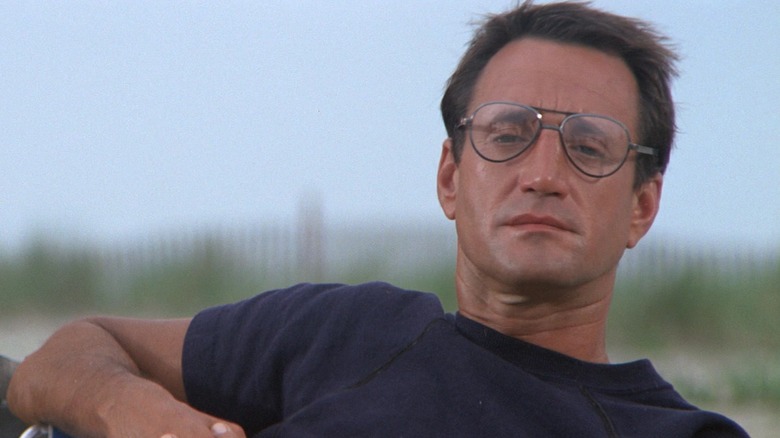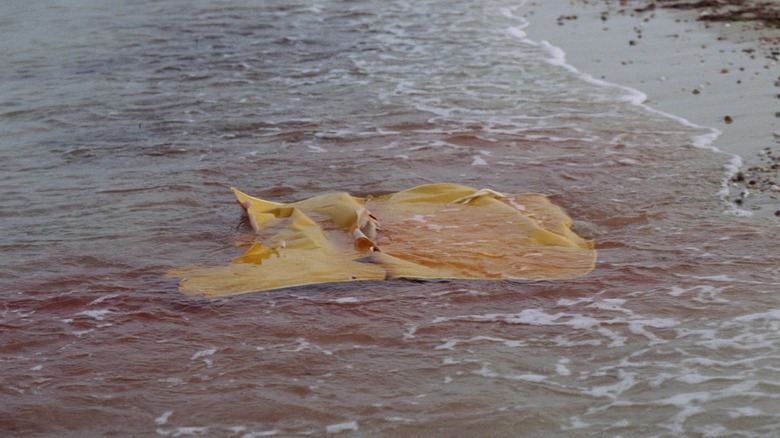The Brilliant Jaws Moment Steven Spielberg Borrowed From Alfred Hitchcock
Steven Spielberg's "Jaws" should be shown to children early in their development. Get them at three or four, before their attention span has been destroyed by an onslaught of screens and other stimuli. Park them in front of good-sized television and let Spielberg's perfectly calibrated mix of adventure and terror overwhelm their senses. Implant that primal fear of getting dragged underwater by a kid-eating Great White Shark, and, once it's all over, after they've slept on it (and experienced the same briny nightmares you endure to this day), tell them that sharks are awesome creatures, actually, that are getting squeezed out of their natural habitats by the worst monsters on the planet: human beings. So when they do choose to feed on us, when we stray onto their turf, they're doing so out of necessity, not preference.
A child's first viewing of "Jaws" is a sacred thing for many reasons, but I think it's essential for the way it hardwires the cinematic language into your brain. There's such explosive creativity on display, but it's also disciplined. Much like The Beatles prior to "Sgt. Pepper's Lonely Hearts Club Band," Spielberg is coloring within the lines. He's just doing so in an off-handed, bratty fashion. He's showing off. When you find out that he nearly got fired due to falling behind schedule (and presiding over a set where the star, a mechanical shark, was inoperable for weeks), you can't believe it. Everything in "Jaws" is just so: big moments and glancing gestures. From the masterfully staged opening set piece to the introduction of Frank Silva, Amity Harbor Master, you're bearing witness to a blessed event. Every time I watch "Jaws," I'm blown away by its texture; it's like Spielberg embedded himself for five years in Martha's Vineyard and surreptitiously assembled slivers of local color.
That texture feels so off-handed (even though it's anything but) that when Spielberg springs the shockingly graphic killing of Alex Kintner on us, we're caught flat-footed. After Chrissie's death, "Jaws" becomes a hang movie. And when you watch the film for the first time, Alex does not initially feel like the likeliest victim on the beach. This is because Spielberg studied his Hitchcock, and turned his Great White Shark's appetite into a ticking time bomb.
Alfred Hitchcok hits the beach
Roy Scheider's Martin Brody is a perfect 1970s movie protagonist. He's not classically handsome, but his creased face tells a story of hard winters as a cop in New York City. It's this face that gazes uncomfortably out toward the Atlantic Ocean on a lazy summer day; it's the face of a man who knows what the rest of the beachgoers do not, that there is a shark lurking in the waters he's been sworn to protect. And because Brody agreed to keep quiet about the shark's presence at the behest of the commerce-obsessed mayor, he is hypervigilant on this day.
Spielberg hooks us directly into Brody's mindset with an Altman-esque suspense sequence that utilizes overlapping dialogue to get our guard down. As the island's chief of police, Brody is lightly hassled by locals looking for favors or just being annoying ("That's some bad hat, Harry") while he hair-trigger reacts to every shriek and visual anomaly in the water. Spielberg fakes us out several times, and fiendishly ramps up our anxiety by placing a stick-fetching dog and a sizable woman into the water. How could a shark resist either one?
We know it's coming. We just don't know which of these eligible warm lunches will be devoured. Spielberg plays a bit of jazz here. Brody is a bit of a voyeur, peering in on the revelry of beachgoers young and old like a sun-worshipping Jeff Jeffries. But Spielberg deftly shifts perspectives. We're watching Brody watch. After a while, we figure he's worked up over nothing. Maybe the mayor was right.
Then it happens. Poor Alex Kintner, whose mother was worried about his pruned fingers, gets bit. The geyser of blood (which I didn't see as a kid because I was brought up on a Betamax copy of the ABC Network premiere) spurts skyward. Then, after a quick shot of people reacting to the attack, Spielberg cuts to the shark's perspective as Alex gurgles one last scream.
And then Spielberg delivers the dolly zoom (a technique that involves pushing the camera forward while also zooming out, creating disorienting effect).
This is Spielberg's homage to "Vertigo," but, like many cinephiles my age, I'd never seen anything like it before. I couldn't identify technique at a young age, but I sure as hell could feel it. Everything goes sideways for Brody in this moment. He's betrayed his community. And once Mrs. Kintner rebukes him for getting her son killed, we need to see Brody, a decent man, redeem himself.
This is the direct line from Hitchcock to Spielberg. It's homage and one-upmanship. And when you process this at a young age, it conveys a sense of aesthetic sophistication. Will your nightmare-stricken kids rush into your room in the middle of the night and snuggle up for security? It's possible. But this is the gift of movies. Savor it. (And watch this lovingly detailed breakdown of the aforementioned sequence.)

